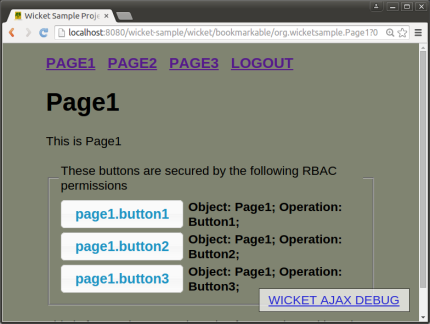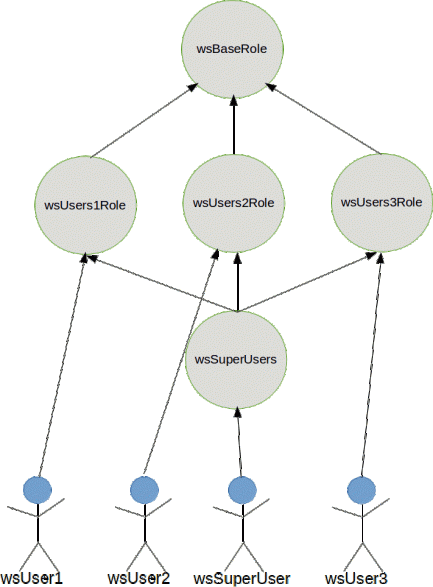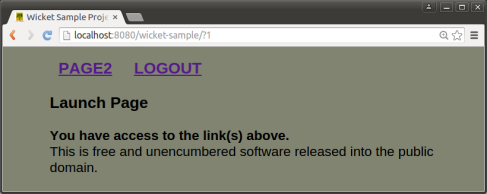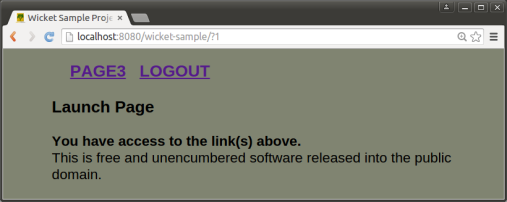Introduction
The aim of this tutorial is to demonstrate how a simple wicket web app can be converted to use java EE and fortress security. It’s not intended to highlight all of the possible locations in code where security checks may be applied. For that take a look at The Apache Fortress End-to-End Security Tutorial.
Course Prerequisites
Before starting, you need a working fortress environment up and running. Complete one of the following:
Steps to Enable Security in Wicket Sample
1. Download the fortress wicket-sample project
a. extract the zip
b. follow the instructions in README.md
You may now hit the sample web app:
http://localhost:8080/wicket-sample
This is the view you will see when clicking on link for Page1. Despite what it says about rbac perms, it’s an example of an app that’s not secured. Users are not required to logon and may navigate freely.
To enable security for this app, continue on…
The following instructions are duplicated by: README-ENABLE-FORTRESS.md
2. Add the Java EE security required artifacts
If you are using the wicket-sample source, this is already done. It includes wicket components LoginPage.java, LogoutPage.java (plus associated markup files LoginPage.html, LogoutPage.html), and the static html files under the /login folder. These files control the flow between the container and wicket with java EE security enabled.
more on java EE security
Declarative style of security, one with no api calls made by programmer (during logon). This makes java EE security both error resistant and hardened to attack, though it tends to get in the way of the page flows. We’ll cover this topic, in more detail, on a future post.
3. Edit the pom.xml
Prepare maven for fortress.
a. Uncomment the fortress web dependency at the top of the file.
<!-- TODO STEP 3: uncomment for fortress security dependency: -->
<dependency>
<groupId>org.apache.directory</groupId>
<artifactId>fortress-web</artifactId>
<version>${project.version}</version>
<classifier>classes</classifier>
</dependency>
b. Uncomment the maven ant task near the bottom of the file.
This plugin calls the fortress load procedure during normal maven tasks like install or deploy. The fortress load inserts the app’s security policy into ldap. It can be overridden by passing param -Dnoload which tells the plugin not to execute.
<plugin>
<artifactId>maven-antrun-plugin</artifactId>
<version>1.7</version>
<executions>
<execution>
<phase>test</phase>
<configuration>
<target name="fortress-load"
if="load.file"
description="Loads wicket sample security policy into ldap">
...
At the completion of this step, the necessary binaries will be available to the app and the app’s security policy file will be ready to load.
4. Edit the web.xml
Prepare the app for fortress.
a. Uncomment the spring settings.
<!-- TODO STEP 4a: uncomment to enable fortress spring bean injection: -->
<context-param>
<param-name>contextConfigLocation</param-name>
<param-value>classpath:applicationContext.xml</param-value>
</context-param>
<listener>
<listener-class>org.springframework.web.context.ContextLoaderListener</listener-class>
</listener>
Notice that we’re including a link to a spring context file: applicationContext.xml:
<?xml version="1.0" encoding="UTF-8"?>
...
<bean id="accessMgr"
class="org.apache.directory.fortress.core.AccessMgrFactory"
scope="prototype"
factory-method="createInstance">
<constructor-arg value="HOME"/>
</bean>
<bean id="j2eePolicyMgr"
class="org.apache.directory.fortress.realm.J2eePolicyMgrFactory"
scope="prototype"
factory-method="createInstance">
</bean>
...
The context file holds the metadata necessary to wire the fortress objects in with their constructors and subsequently get injected into the web app as spring beans.
b. Uncomment the java ee security constraints from web.xml:
<!-- TODO STEP 4b: uncomment to enable Java EE Security: -->
<security-constraint>
...
Now container security has been enabled for this web app. It authenticates, checks roles and maintains the session.
The wicket logout page is excluded from java EE security constraints. Otherwise, a problem occurs preventing unauthorized users from logging out.
<security-constraint>
<web-resource-collection>
<web-resource-name>app</web-resource-name>
<url-pattern>/wicket/bookmarkable/org.wicketsample.LogoutPage</url-pattern>
</web-resource-collection>
<!-- OMIT auth-constraint -->
</security-constraint>
5. Rename context.xml.example to context.xml
Prepare the app for the fortress realm.
<Context reloadable="true"> <Realm className="org.apache.directory.fortress.realm.tomcat.Tc7AccessMgrProxy" debug="0" resourceName="UserDatabase" defaultRoles="" containerType="TomcatContext" realmClasspath="" /> </Context>
This file hooks a web app into the tomcat fortress realm which performs security functions like authenticate and isUserInRole. It’s also where the security session gets created by fortress.
more on the realm
The fortress realm’s proxy jar must be present under tomcat’s lib folder (as discussed in the quickstarts).
The proxy jar is a shim that uses a URLClassLoader to reach its implementation libs. The proxy prevents the realm impl libs, pulled in as dependency to web app, from interfering with the container’s system classpath thus providing an error free deployment process free from classloader issues. The proxy offers the flexibility for each web app to determine its own version/type of security realm to use, satisfying a variety of requirements related to web hosting and multitenancy.
6. Rename fortress.properties.example to fortress.properties.
Prepare fortress for either apacheds or openldap server usage.
Pick One:
a. ApacheDS
# This param tells fortress what type of ldap server in use: ldap.server.type=apacheds # ldap host: host=localhost # ldap port: port=10389 # These credentials are used for read/write access to all nodes under suffix: admin.user=uid=admin,ou=system admin.pw=secret # This is min/max settings for LDAP administrator pool connections that have read/write access to all nodes under suffix: min.admin.conn=1 max.admin.conn=10 # This node contains fortress properties stored on behalf of connecting LDAP clients: config.realm=DEFAULT config.root=ou=Config,dc=example,dc=com # Used by application security components: perms.cached=true # Fortress uses a cache: ehcache.config.file=ehcache.xml
b. OpenLDAP
# This param tells fortress what type of ldap server in use: ldap.server.type=openldap # ldap host: host=localhost # openldap default port: port=389 # These credentials are used for read/write access to all nodes under suffix: admin.user=cn=Manager,dc=example,dc=com admin.pw=secret # This is min/max settings for LDAP administrator pool connections that have read/write access to all nodes under suffix: min.admin.conn=1 max.admin.conn=10 # This node contains fortress properties stored on behalf of connecting LDAP clients: config.realm=DEFAULT config.root=ou=Config,dc=example,dc=com # Used by application security components: perms.cached=true # Fortress uses a cache: ehcache.config.file=ehcache.xml
7. Edit WicketApplication.java
Tell wicket about fortress sessions and objects.
a. Uncomment fortress session override.
Here we override app’s wicket session with a new one that can hold onto fortress session and perms:
// TODO STEP 7a: uncomment save fortress session to wicket session:
@Override
public Session newSession(Request request, Response response)
{
return new WicketSession(request);
}
b. Uncomment fortress spring bean injector.
Next we tell the app to use spring to inject references to fortress security objects:
// TODO STEP 7b: uncomment to enable injection of fortress spring beans: getComponentInstantiationListeners().add(new SpringComponentInjector(this));
These steps are necessary to get fortress runtime wired into the sample app.
8. Edit WicketSampleBasePage.java
Get fortress objects injected to the wicket base page, enable fortress secured page links.
a. Uncomment fortress spring bean injection.
This step automatically instantiates the fortress objects needed for security processing.
// TODO STEP 8a: enable spring injection of fortress bean here: @SpringBean private AccessMgr accessMgr; @SpringBean private J2eePolicyMgr j2eePolicyMgr;
These objects are used by the app to make AccessMgr calls to functions like checkAccess and sessionPermissions.
b. Uncomment call to enableFortress.
This performs the boilerplate security functions required by fortress during app session startup:
// TODO STEP 8b: uncomment call to enableFortress:
try
{
SecUtils.enableFortress(
this, ( HttpServletRequest ) getRequest().getContainerRequest(),
j2eePolicyMgr, accessMgr );
}
catch (org.apache.directory.fortress.core.SecurityException se)
{
...
}
c. Change to FtBookmarkablePageLink
The advantage here is other than a name change, everything else stays the same, and now the links are secured.
// TODO STEP 8c: change to FtBookmarkablePageLink: add( new FtBookmarkablePageLink( "page1.link", Page1.class ) ); add( new FtBookmarkablePageLink( "page2.link", Page2.class ) ); add( new FtBookmarkablePageLink( "page3.link", Page3.class ) );
This component maps a page link to a fortress permission. The wicket id passed in, e.g. page1.link, is converted to a fortress permission, objName: page1, opName: link.
9. Edit Page1.java, Page2.java, Page3.java
Enable fortress secured buttons. Each page has three buttons. Same as before, only the name changes.
a – i. change the button class name to FtIndicatingAjaxButton:
// TODO STEP 9a: change to FtIndicatingAjaxButton: add( new FtIndicatingAjaxButton( "page1.button1" )
This component maps the buttons to fortress permissions. The wicket id, e.g. page1.button1, is converted to a fortress permission, objName: page1, opName: button1.
10. Build & Deploy Web App
Deploy to tomcat server:
mvn clean tomcat:deploy -Dload.file
Or if already deployed:
mvn clean tomcat:redeploy -Dload.file
The -Dload.file system parameter tells maven to load the wicket sample security policy into ldap in addition to deploying the app. Since the load needs to happen just once, you may drop it from future invocations:
mvn tomcat:redeploy
We’re done with setup. Now onto testing…
Testing the Sample App Security Policy
The wicket-sample security policy is loaded automatically during maven deployment step. The file: wicket-sample-security-policy.xml
How to create an rbac policy was covered recently:
The Seven Steps of Role Engineering
The diagram below depicts the wicket sample role hierarchy and its user to role assignments:
- wsBaseRole is inherited by all other roles
- wsSuperUsers inherits wsUsers1Role, wsUsers2Role and wsUsers3Role
- wsUser1 is assigned wsUsers1Role and has access to buttons on Page1
- wsUser2 is assigned wsUsers2Role and can hit buttons on Page2
- wsUser3 is assigned wsUsers3Role and has buttons on Page3
- wsSuperUser is assigned wsSuperUser role has all pages and all buttons
Use Cases for Testing
a. wssuperuser/password
Receives links for Page1, Page2 and Page3.
b. wsuser1/password
Receives a page link for Page1. May only view and click on Page1’s buttons.
c. wsuser2/password
Receives link for Page2. May only view and click on Page2’s buttons.
d. wsuser3/password
Receives link for Page3. May only view and click on Page3’s buttons.
More on sample security policy
As stated in the beginning, the sample wicket security controls are not comprehensive. For example, a user may navigate by manually entering page urls thus sidestepping the secured page link component. In this scenario the user will be prevented from clicking on buttons unless otherwise authorized. Still, allowing users to navigate to unauthorized pages is a bad practice. The Apache Fortress End-to-End Security Tutorial uses spring security controls to lock down pages. There are many other ways – how would you do it?










Hi, I’m trying to fulfill all the steps you described here. But It looks like I did something wrong. When I start the wicket-sample webapp in tomcat I get following errors in catalina.out:
INFORMATION: org.apache.directory.fortress.realm.tomcat.Tc7AccessMgrProxy.initialize Tomcat7 Context-based policy agent
Sep 01, 2015 3:47:01 PM org.apache.directory.fortress.realm.tomcat.Tc7AccessMgrProxy initialize
INFORMATION: org.apache.directory.fortress.realm.tomcat.Tc7AccessMgrProxy.initialize – instantiate policy agent name: org.apache.directory.fortress.realm.tomcat.TcAccessMgrImpl
Sep 01, 2015 3:47:01 PM org.apache.directory.fortress.realm.tomcat.Tc7AccessMgrProxy initialize
SCHWERWIEGEND: org.apache.directory.fortress.realm.tomcat.Tc7AccessMgrProxy.initialize caught java.lang.ClassNotFoundException=java.lang.ClassNotFoundException: org.apache.directory.fortress.realm.tomcat.TcAccessMgrImpl
Sep 01, 2015 3:47:01 PM org.apache.directory.fortress.realm.tomcat.Tc7AccessMgrProxy startInternal
SCHWERWIEGEND: org.apache.directory.fortress.realm.tomcat.Tc7AccessMgrProxy.startInternal caught Exception=java.lang.RuntimeException: org.apache.directory.fortress.realm.tomcat.Tc7AccessMgrProxy.initialize caught java.lang.ClassNotFoundException=java.lang.ClassNotFoundException: org.apache.directory.fortress.realm.tomcat.TcAccessMgrImpl
java.lang.RuntimeException: org.apache.directory.fortress.realm.tomcat.Tc7AccessMgrProxy.initialize caught java.lang.ClassNotFoundException=java.lang.ClassNotFoundException: org.apache.directory.fortress.realm.tomcat.TcAccessMgrImpl
at org.apache.directory.fortress.realm.tomcat.Tc7AccessMgrProxy.initialize(Tc7AccessMgrProxy.java:99)
at org.apache.directory.fortress.realm.tomcat.Tc7AccessMgrProxy.startInternal(Tc7AccessMgrProxy.java:219)
at org.apache.catalina.util.LifecycleBase.start(LifecycleBase.java:150)
at org.apache.catalina.core.StandardContext.startInternal(StandardContext.java:5400)
at org.apache.catalina.util.LifecycleBase.start(LifecycleBase.java:150)
at org.apache.catalina.core.ContainerBase.addChildInternal(ContainerBase.java:901)
at org.apache.catalina.core.ContainerBase.addChild(ContainerBase.java:877)
at org.apache.catalina.core.StandardHost.addChild(StandardHost.java:652)
at org.apache.catalina.startup.HostConfig.deployWAR(HostConfig.java:1095)
at org.apache.catalina.startup.HostConfig$DeployWar.run(HostConfig.java:1930)
at java.util.concurrent.Executors$RunnableAdapter.call(Executors.java:511)
at java.util.concurrent.FutureTask.run(FutureTask.java:266)
at java.util.concurrent.ThreadPoolExecutor.runWorker(ThreadPoolExecutor.java:1142)
at java.util.concurrent.ThreadPoolExecutor$Worker.run(ThreadPoolExecutor.java:617)
at java.lang.Thread.run(Thread.java:745)
Caused by: java.lang.ClassNotFoundException: org.apache.directory.fortress.realm.tomcat.TcAccessMgrImpl
at java.net.URLClassLoader$1.run(URLClassLoader.java:372)
at java.net.URLClassLoader$1.run(URLClassLoader.java:361)
at java.security.AccessController.doPrivileged(Native Method)
at java.net.URLClassLoader.findClass(URLClassLoader.java:360)
at java.lang.ClassLoader.loadClass(ClassLoader.java:424)
at java.lang.ClassLoader.loadClass(ClassLoader.java:357)
at org.apache.directory.fortress.realm.tomcat.Tc7AccessMgrProxy.initialize(Tc7AccessMgrProxy.java:90)
… 14 more
Sep 01, 2015 3:47:01 PM org.apache.catalina.core.ContainerBase addChildInternal
SCHWERWIEGEND: ContainerBase.addChild: start:
I checked the fortress-realm-proxy-1.0-RC41-SNAPSHOT.jar ist present in tomcats lib-folder. What am I missing here?
Thanks, Henry
LikeLike
P.S. I have the fortress-web app running on the same tomcat server. There I don’t get this error and the rbac-Role checking seems to work.
LikeLike
Hello Henry,
Yes you do have the realm proxy jar else it wouldn’t have tried to load the org.apache.directory.fortress.realm.tomcat.TcAccessMgrImpl class. This resides inside the wicket-sample.war/lib – fortress-realm-impl-1.0-RC41-SNAPSHOT.jar. Doubt you would have successfully deployed if it wasn’t staged correctly so my guess is you skipped a step. It looks like the proxy can’t find the impl jars via the URLclassloader. Did you rename the /META-INF/context.xml.example file before you deployed wicket-sample to Tomcat?
LikeLike
Thanks for your reply.
The problem was, that I was not able to redeploy my wicket-sample-app to tomcat. Tomcat got errors on removing the web-app because not all files could be removes (in use?):
SCHWERWIEGEND: [C:\apache\apache-tomcat-7.0.64\webapps\wicket-sample\WEB-INF] could not be completely deleted. The presence of the remaining files may cause problems
So I had to shutdown tomcat (kill hard, because it did not shut down properly) and then remove the webapp-folder manually.
After deploying again everything was fine.
LikeLiked by 1 person
I use ShieldUI for JAVA Apache Wicket, because it offers the same set of feature richness and fast performance as the JavaScript components, wrapped as a JAVA Apache Wicket control. Check it out on https://www.shieldui.com/products/java-wicket
LikeLike